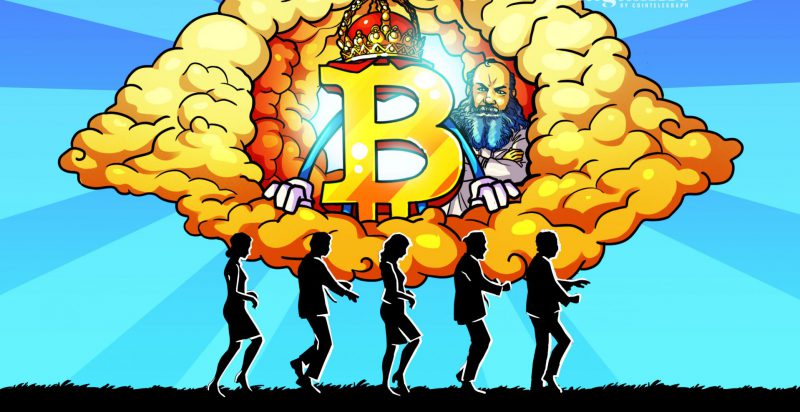Rituals, terminology, and evangelism-,These aspects define Bitcoin as a religion.
During bitcoin’s sudden rise this year, Twitter followers with laser eyes came live. The hashtag #LaserRayUntil100k began to spread after “anons.” Also, celebrities such as Elon Musk applied red laser rays to their photographs. As the hashtag indicated, the laser eyes were part of an internet ritual to raise bitcoin’s price to $100,000. Yet, the laser eye is the most recent manifestation of Bitcoin’s culture.
Yet, if we disregard these cult-like rites, we will miss out on their weight in Bitcoin’s acceptance.
Indeed, we must recognize Bitcoin as a religion dimension. It shows itself in the beliefs of some of the ardent fans and their analysis of Nakamoto’s code and writings if we are to understand Bitcoin’s apparent growth.
The launch of bitcoin took place a decade ago. Yet, it’s been the pioneer’s strong commitment and free psyche that has fed its popularity. Bitcoin users’ evangelism is a crucial aspect of the crypto’s technological diffusion.
Bitcoin as a Religion
Bitcoins online rituals and Bitcoins origin resemble religious practices. Bitcoin, like religion, has its creation myth. It began as a dark and wholly new technology built by a mystery patron who later faded.
One of the most crucial traits is that Satoshi Nakamoto and religious leaders have a lot in common. Nakamoto sacrificed his estimated 1,148,800 bitcoin for a messianic vision. He wanted an alternative to fiat currencies and central banking.
Bitcoin is the greatest invention of our time. It has created a new section of arithmetic. Besides, it can transform public blockchain technology to levels never before imagined. Bitcoin runs more applications than anyone could ever think.
Similarly, the white paper’s importance might compare to sacred scripture in faiths. The Nakamoto identity has become a point of dispute among crypto fans and scholars. The white paper is vague about who the inventor was, but many people try to decipher it in various ways. Some say they can find clues. Yet, others think they should take everything at face value without any guess or analysis.
A Safe Alternative to Fiat Money
The last decade has seen a series of hard forks for cryptocurrency. For example, Bitcoin Cash arose in the summer of 2017. And it was an issue of developer disputes over block size and transaction throughput. They divided Bitcoin into two separate protocols.
For example, so-called Bitcoin maximalists see bitcoin as a form of digital gold. This viewpoint promotes bitcoin as a “safe” alternative to fiat money. Bitcoin has a limited supply. Advocates of this aspect claim bitcoin is a digital store of value. They believe bitcoin is the sole genuine crypto because of its fiscal effects. Champions of Bitcoin forks think that they can use Bitcoin for small transactions.
Bitcoin has rival groups with a different belief in the sacred white paper and original code. The zealots who hold in Nakamoto’s vision are often at war on those who have created alternative coins.
Running a Bitcoin node is one of the essential rituals in cryptocurrency. These full-nodes pick the option they want to follow, thus operating software that offers protocol rules. Working on the Bitcoin node draws the power that selects, implements, and affects the system’s limitations.
Participants in the network develop an intersubjective accord about what sets “Bitcoin.” They use the same set of validation tests. Dissenting web members can only “hard fork” the protocol to leave the meaning of Bitcoin. The protocol becomes compliant with their belief and interpretation of the white paper.
Wences Casares has been spreading Nakamoto’s “utopia” to Silicon Valley venture capitalists
Wences Casares has been spreading Nakamoto’s “utopia” to Silicon Valley venture capitalists. A technology entrepreneur with interest in crypto and blockchain-based systems for finance. He saw potential when bitcoin was still a proof of concept back in its early days.
Early Bitcoin users’ intense confidence aroused the curiosity of earlier critics and investors. Most of whom were well motivated to invest in the technology. The initial Bitcoin bubbles in 2012 and 2013 sparked the strain of capital and attention.
Bitcoin’s price dropped to a low point, and then it started climbing again. This bubble burst led many new investors into the world of cryptocurrency. They saw value in its technology despite all setbacks before them.
The price of bitcoin showed stability for two years before it began building a new base in 2015. So, adopters were waiting on their next opportunity to buy bitcoins at an affordable cost. And become part of what’s known as “the greatest Bull Market.” The next bubble generation brought more excitement into cryptocurrency, with 2017 being exceptional.
Bitcoin is a creation to be an alternative currency, but it has grown into something much more. Bitcoin’s history of bubbles and hype cycles is proof that belief in technology can fix a network.
The religious aspect of Bitcoin is critical in the acceptance and diffusion of technology. We can’t merely believe in Bitcoin for it to succeed. Money tends to settle on a single standard in a free market. To attract liquidity, a crypto’s incentive design and protocol type must be superior to others.
Bitcoin remains superior to Altcoins
Bitcoin has superior qualities that altcoins can never match. It’s possible to split Bitcoin, but not the network effects. Or security it provides for its users with long track records in reliability.
Bitcoin has superior qualities that altcoins can never match. It’s possible to split Bitcoin, but not the network effects. Or security it provides for its users with long track records in reliability. Bitcoin’s market valuation has grown from $0 to over $1 trillion in ten years. This is an incredible feat for any financial instrument, and Bitcoin was no exception.
Core developers like HODLers or Entrepreneurs can have credit for this rapid growth. They’ve shown dedication towards bitcoin itself rather than relying on government-issued currencies, as Christianity teaches us. A handful of devoted Christians who work for one cause will always have more impact.
As investor Peter Thiel once said: “The best startups might be less extreme kinds of cults. The biggest difference is that cults tend to be fanatically wrong about something. People at a successful startup are fanatically right about something.”
Will more people start to believe in the prophecy of Satoshi Nakamoto? It will be interesting to watch how things will unfold. So far, the Bitcoin cult has been fanatically right.





